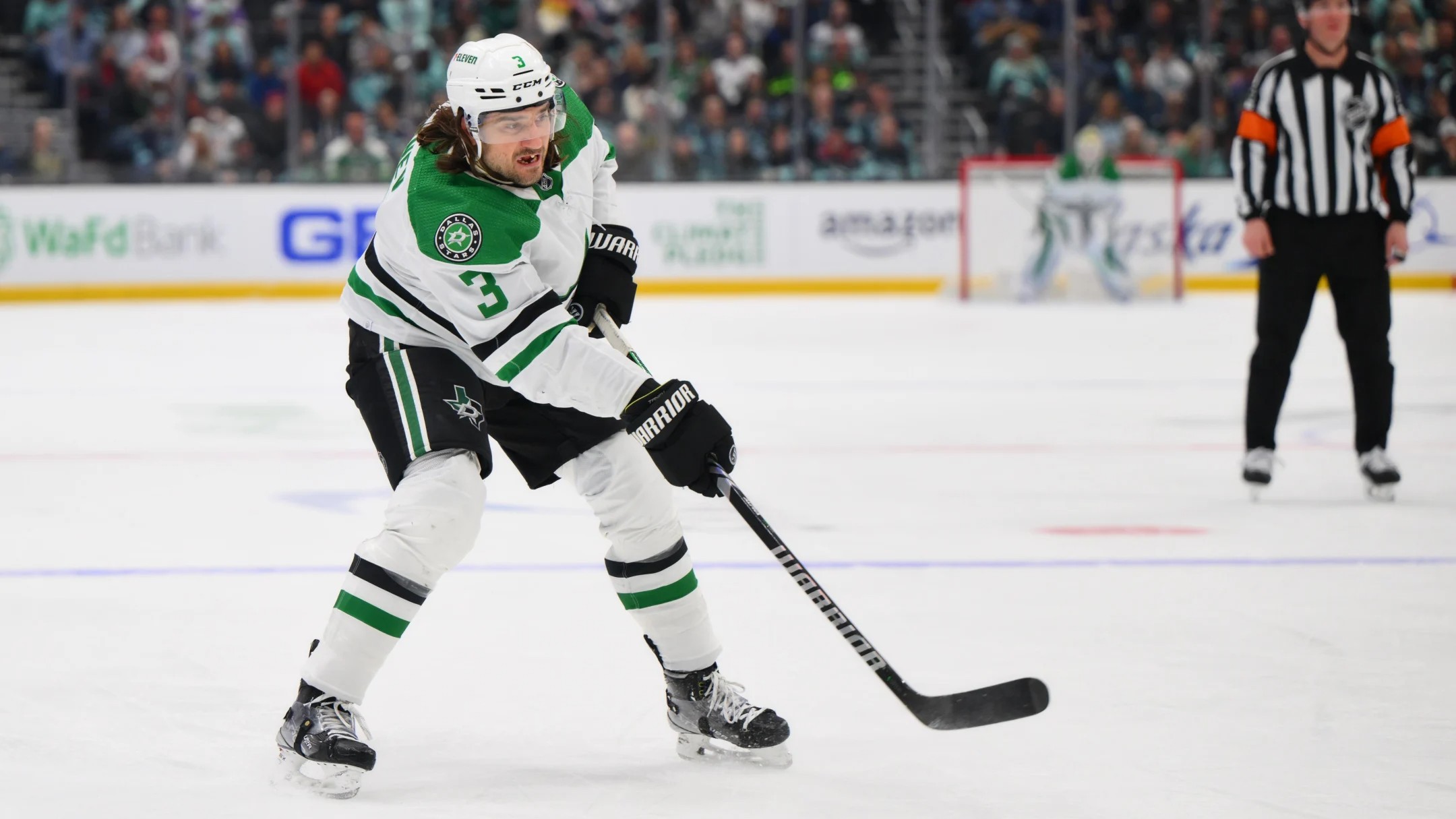Finally, the Maple Leafs have landed a proper top-four right-handed defenseman. It comes with a six-year term ($4.5 million AAV) for the 34-year-old Chris Tanev.
How Tanev can change the Leafs‘ blue line for the better (significantly) and where he could fit (Morgan Rielly’s best-ever RD partner, or perhaps on a shutdown pairing with Jake McCabe) was covered in-depth by our own Anthony Petreilli when the Leafs made the trade for Tanev’s rights:
First and foremost, we should note that Tanev was, once again, excellent last season. His work in the first two rounds of the playoffs was nothing short of special while matching up against elite players by and large.
Tanev isn’t a bruising, big-time hitter, but he’s excellent at reading the play, breaking up offensive-zone sequences, blocking passing lanes, and getting in shooting lanes. He will fearlessly get in the way of shots; I don’t say it lightly: He is a warrior who puts his body on the line. He is legitimately one of the best defensive defensemen in the league and an excellent penalty killer, but how long he will be able to keep this up is a fair question.
With a December 20, 1989 birth date, Tanev is slated to turn 35 at the end of this year and has a lot of wear and tear on his body. The Leafs had the all-time shot block leader on their team at age 40, and it wasn’t really until the last playoffs (at 39) that Mark Giordano’s game really fell off to the point where it became problematic.
One of the more underrated parts of Tanev’s game is his ability to lead the breakout. He’s not going to produce much offensively – his previous career high in points is 28, and he does not own a good shot from the point – but he gets the puck moving the right way cleanly from his own end. Since leaving a mediocre Vancouver team (at the time) to a solid Calgary team (at the time), he has decidedly won his minutes in terms of shot attempts, chances, and overall goals, even though he has largely been tasked with matching up against elite players in that time.
Further, it is not only the crisp passes that are often tape to tape but also how he moves his feet to create passing lanes. On his side of center ice, Tanev is very good at skating with the puck and opening up passing lanes by moving his feet to lead clean breakouts. This is, by and large, not a glass-and-out type of player. He will move the puck cleanly up ice, which is a welcome addition to a Leafs team with all sorts of talent up front that needs to be facilitated properly with the puck.
I thought this was an interesting note from Dom at The Athletic in his UFA defensemen primer: “Tanev exited with control 61 percent of the time last season, one of the best marks in the league. Very few retrieve as many pucks as he does, at 29.9 per 60.”
Tanev didn’t only do well; he more or less completely shut down two elite players in their primes. At the deadline, we noted that he was more or less a perfect acquisition given the Leafs’ needs (penalty killer, top-four defenseman, right-handed), and after a really strong playoffs, this continues to be the case, although they also need to find some offense from the back end at some point.
If Tanev simply continues to be the player he’s been, he’s an excellent addition who makes the Leafs significantly better. Toronto’s third-most played defenseman last playoffs was Joel Edmundson, who Tanev is notably better than. Morgan Rielly’s partner last playoffs was Ilya Lyubushkin, who Tanev is notably better than as well. This gives the Leafs three top-four defensemen, which hasn’t been the case since TJ Brodie was in the middle of his contract and Jake Muzzin was healthy.
Watching how the Leafs coaching staff deploys Tanev will be very interesting. They can simply play him with Morgan Rielly, and he would instantly become the best right-handed partner Rielly has played with in Toronto as he enters his 12th(!) year with the franchise. It’s a bit of a yin and yang pairing, as Rielly would drive offense and Tanev would drive defense, and it’s something Tanev is very used to. He has paired very well with offensive left defensemen Quinn Hughes and Noah Hanifin.
Conversely, the Leafs could consider moving Jake McCabe back to the left side and pairing him up with Tanev, making a true shutdown defense pairing. Both Tanev and McCabe are capable puck movers who can push for 20-ish points. Neither is inept with the puck, so it wouldn’t be a shutdown pairing the coaching staff would have to worry about in terms of its ability with the puck. It would also, on paper, put together their two best defensive defensemen (as it stands today). Should it work, it makes for a set-it-and-forget-it pairing that can handle tough matchups nightly. The Dallas Stars did this with Tanev and Esa Lindell, freeing up Miro Heiskanen to run wild.
Frankly, the Leafs should try both configurations.
Anthony also wrote the following about the potential contract structure:
If the Leafs go down the rabbit hole of pushing term in the five-plus years range, it needs to come with a massive break on the annual average. For example, a six-year, $3.5 million annually is $21 million in total dollars and gives the Leafs big savings in the short run. Even if Tanev maintained his current level of play for just two seasons before declining, he would be worth at least $2 million more in those seasons than the $3.5 million AAV – a massive break for the Leafs.
If it’s in the six-year range and still north of $4 million, totaling well over $24 million, I’d rather offer a $5 million annual salary for four years—give or take—and not take on the extra two years of headaches from an accounting standpoint.
Matthews’ four-year deal starts next season. Even if they retain him beyond then, these are the prime years of a generational talent. Even if the Leafs don’t retain Marner, they also have William Nylander in the middle of his prime. This is the type of deal they previously avoided, pushing down AAV with term (most notably with Zach Hyman). Now, Hyman was younger, and it’s not an exact comparable; it’s just to say that if the only way to beat the market is to bargain bin shop and hunt value on the cheap – not taking other avenues to add a quality player well below what he’s worth before taking it on the chin later on – then it’s very hard to win. And it has been very hard for the Leafs to win.
We will see where the Tanev contract settles shortly, but the Leafs should pay with the AAV to secure less term or pay with the term to push down the AAV, while making sure to use the rest of that space properly to load up the roster. It can’t be somewhere in between where it’s a big term and a big AAV for a 34-year-old defenseman.
Six years for $4.5 million AAV, taking Tanev to 40 years old, shades on the riskier side of the term length/corresponding-savings-on-the-AAV scale. Assuming Tanev is approximately as effective as he was in 2023-24, it would be fair to suggest he is worth at least $1 million more than he’s paid in 2024-25, but then it becomes all about a) how gracefully he ages, b) finding a way to remove the contract from the cap books if it does go south in a few years.
Regarding the latter challenge, there is technically the possibility of early retirement (this involves relinquishing the salary — which will likely be smaller in the final years of the contract — but it is not an age-35+ contract in this case), or Long-Term Injured Reserve. The latter is much more likely, even if it might draw the ire of the league, but a contract such as Kris Letang’s current six-year deal shows this is not unheard of, and the current rules are the current rules.
Still, ideally, with the risk or potential LTIR headache associated with a six-year term for a 34-year-old, the savings on the AAV would’ve been at least a little more significant than a $4.5 million AAV. However, it’s also worth noting the amount of interest in the market for Tanev’s services. Ottawa was prepared to tender a meaty contract offer, for example, among other suitors.
The Leafs have no top-of-the-lineup right-handed solutions internally. Brandon Montour was out of their price range (barring a more dramatic reshaping of their roster and cap construction), Brett Pesce chose New Jersey, Matt Roy appears to have a different preferred destination in mind, and Tanev ticks all kinds of boxes: an elite defensive defenseman, excellent PKer, a right-shot, a perfect playing-style complement to Morgan Rielly, and a history with Treliving, who knows the personality/character.
The picture is coming into focus for the Leafs’ blue line, assuming Darren Dreger’s report of Oliver-Ekman Larsson’s likelihood to sign in Toronto is true:
Morgan Rielly – Chris Tanev
Simon Benoit – Jake McCabe
Oliver Ekman-Larsson – Timothy Liljegren
Conor Timmins
There is a better lefty-righty balance, a proper partner for Rielly (which could theoretically uplift Rielly’s play notably), and probably more offense from this D group than last year. OEL and Tanev are a certain upgrade over Ilya Lybushkin at RD and Joel Edmundsson at LD. In an offseason with a lot of quality defensemen available, is it enough of an improvement to get the Leafs where they need to go at playoff time? Remains to be seen.















![John Gruden after the Leafs prospects’ 4-1 win over Montreal: “[Vyacheslav Peksa] looked really comfortable in the net… We wouldn’t have won without him” John Gruden, head coach of the Toronto Marlies](https://mapleleafshotstove.com/wp-content/uploads/2025/09/gruden-post-game-sep-14-218x150.jpg)



















